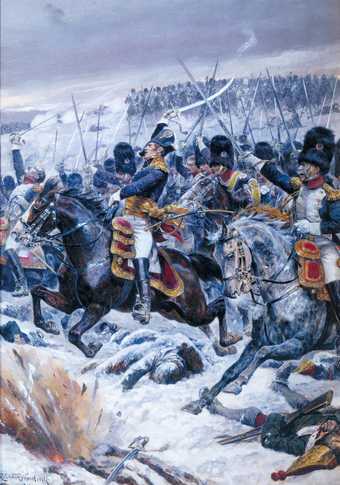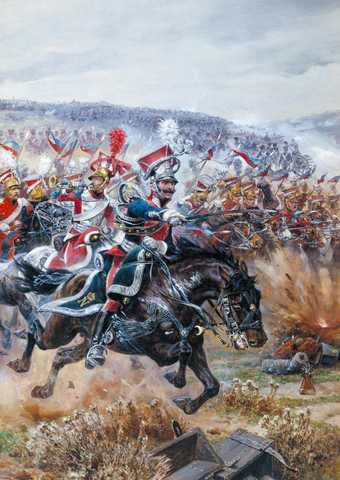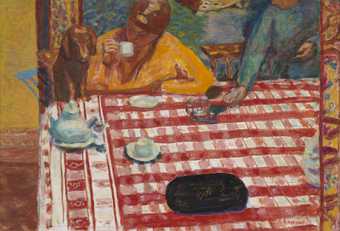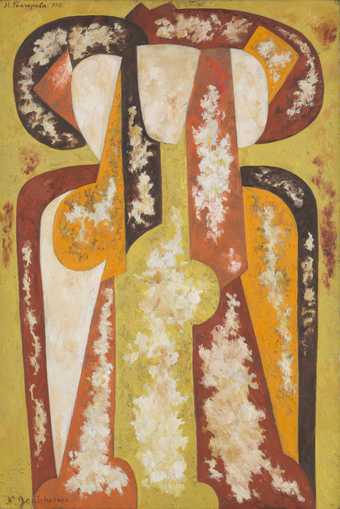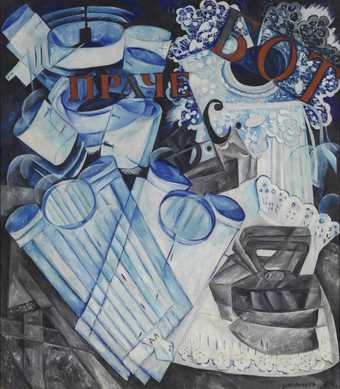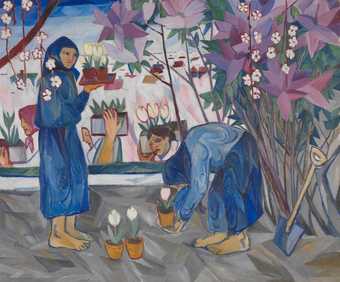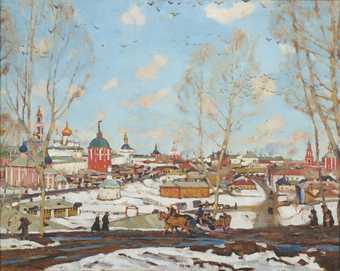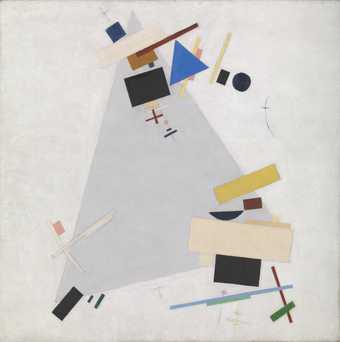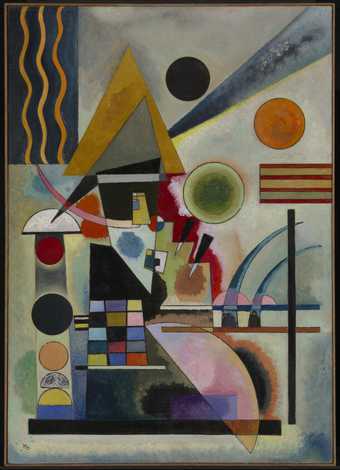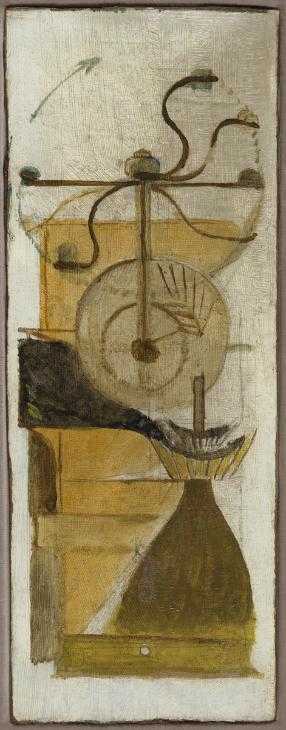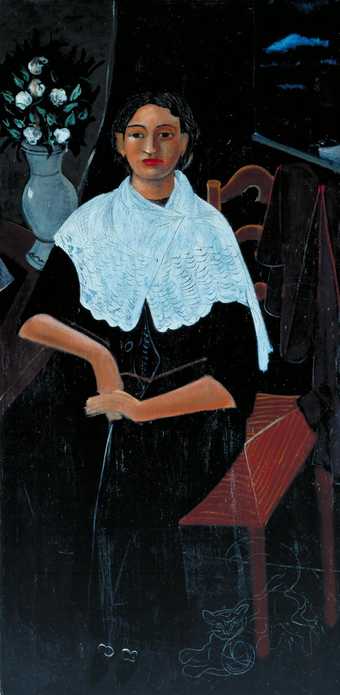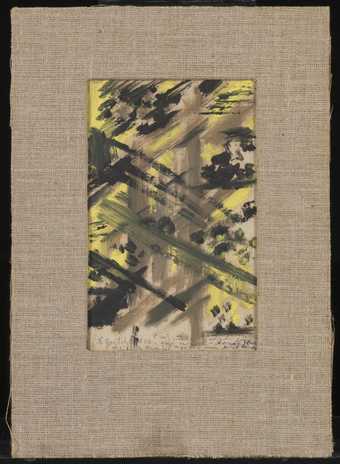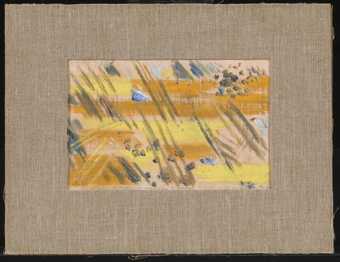
Not on display
- Artist
- Wassily Kandinsky 1866–1944
- Original title
- Cosaques
- Medium
- Oil paint on canvas
- Dimensions
- Support: 946 × 1302 mm
frame: 1118 × 1477 × 74 mm - Collection
- Tate
- Acquisition
- Presented by Mrs Hazel McKinley 1938
- Reference
- N04948
Display caption
WHAT EMOTION DO YOU FEEL WHEN YOU THINK OF A COLOUR?
The ‘cossacks’ of the title are Russian cavalrymen which you can just recognise from their orange hats at the top and right of the painting. However Wassily Kandinsky believed paintings did not need to represent the real world. He felt that emotions could be expressed through the way colours and lines were arranged in a painting. He linked musical tones to particular colours, and considered colour to have a powerful spiritual impact. Can you hear music when you look at the painting??
‘The first colours which made a strong impression on me were light juice green, white, crimson red, black and yellow ochre. These memories go back to the third year of my life.’
Start Gallery caption, 2016
Gallery label, July 2017
Does this text contain inaccurate information or language that you feel we should improve or change? We would like to hear from you.
Catalogue entry
Wassily Kandinsky 1866-1944
N04948 Cossacks
1910-11
Inscribed 'Kandinsky 1910' b.r. and, on stretcher, 'KANDINSKY-Zu Komposition 4 (Fragment) 1910' and 'No.119 | 130 x 94'
Oil on canvas, 37 1/4 x 51 1/4 (94.5 x 130)
Presented by Mrs Hazel McKinley 1938
Prov:
Mrs Hazel McKinley, London (purchased from the artist through Guggenheim-Jeune, London, 1938)
Exh:
Kandinsky, Kunsthaus Schaller, Stuttgart, 1928 (no catalogue); 20th Century German Art, New Burlington Galleries, London, July 1938 (211, ex catalogue) as 'Cosaques' 1911; The Blue Rider Group, RSA, Edinburgh, August-September 1960 (60) as 'Study for Composition IV' 1911; Tate Gallery, September-October 1960 (60)
Lit:
Kandinsky, 'Komposition 4: nachträgliches Definieren' in Kandinsky 1910-1913 (Sturm-Album, Berlin 1913), pp.23-4; Kenneth Lindsay, 'The Genesis and Meaning of the Cover Design for the First Blaue Reiter Exhibition Catalogue' in Art Bulletin, XXXV, 1953, pp.48-9, repr. facing p.48, fig.7; Will Grohmann, Wassily Kandinsky: Life and Work (London 1959), No.119, pp.121-3 and 331, repr. p.353, pl.52; Paul Overy, Kandinsky: the Language of the Eye
(London 1969), pp.62-3, repr. pl.15 in colour
Repr: The Tate Gallery
(London 1969), p.125 in colour
This picture is related to the left-hand section of the much larger 'Composition 4' now in the Kunstsammlung Nordrhein-Westfalen at Düsseldorf, which measures 159.5 x 250.5cm. It appears as No.119 in Kandinsky's house catalogue, where it is dated 13 January 1911, which conflicts with the date 1910 on the picture itself: presumably it was either finished in 1911 or painted at the end of 1910 and not entered in the catalogue until a few weeks later. ('Composition 4' is No.125 in the house catalogue and the five intervening numbers refer to completely different compositions).
Both pictures are 'objective abstractions' in which an expressive arrangement of colours and lines is of primary importance, but a certain representational element still remains. In the Tate's painting one can identify: top left, two Cossacks on horseback fighting with sabres; bottom right, three more Cossacks, two of whom hold lances; top right, a castle on a hill and a party of birds in flight. All these features except the birds are also present in 'Composition 4' but are compressed sideways in order to fit almost exactly into the left-hand half of the composition, with the right-hand lance forming a vertical division down the centre. The right-hand part includes several additional themes, particularly two lying figures which introduce a diagonal movement to the right. Kandinsky wrote a retrospective analysis of 'Composition 4' in March 1911 (first published in the Sturm-Album of 1913) which describes it both in abstract terms (effects produced purely by different colours and forms) and in terms of specific objects (horses, figures, the castle and so on); this analysis also applies to some extent to the present work.
Will Grohmann referred to the Tate's picture as an oil study for 'Composition 4', but the five preliminary drawings which are known for the larger picture, a charcoal drawing, two brush drawings and two watercolours, are all studies for the complete composition, including the right-hand section, and therefore do not really bridge the gap between them. In Kandinsky's hand list 2 the picture is listed in Russian as 'Fragment Kompozitsiyi 4 (13.1.)' - that is to say 'Fragment of Composition 4 (13.1.)' - but in his hand list 3 written by Gabriele Münter (which appears to be a draft for hand list 2 written by Kandinsky himself), it appears as:
119. Improvisation 17 (Schlacht) 13.1.
Zu Komp. 4 (Fragment) Fragment zu Comp. 4
(The first part of the title, 'Improvisation 17', was afterwards crossed out by Münter). The fact that Gabriele Münter or Kandinsky, or both, originally thought of calling the picture 'Improvisation 17' may be an indication that Kandinsky painted it as an end in itself, and not a study, and that he only decided later on to extend the composition or to use some of the same motifs again in a larger work. 'Schlacht' (Battle) is the subtitle both of this picture and of 'Composition 4'. Although there are paintings entitled 'Improvisation 16' (dated 1910) and 'Improvisation 18' (dated 1911), there appears to be no other work known as 'Improvisation 17'.
Hans Konrad Roethel, who has provided much helpful information about this picture, has drawn attention to a letter by Kandinsky to Galka Scheyer of 13 January 1939 (now in the Norton Simon Museum at Pasadena) commenting on its acquisition by the Tate:
'An American woman living in London has bought a pre-war painting from me and presented it to the Tate Gallery in London! It is the first truly modern painting in the famous museum in London. The painting is called "Cosaques", dates from the year 1911, still bears traces of "the object", but makes nevertheless a wholly "concrete" impression.'
Thus the painting has been variously known as 'Cossacks', 'Improvisation 17', 'Battle', 'Fragment for Composition 4' and 'Composition 4 (Fragment)'. The title 'Cossacks' has been adopted here because it is the one Kandinsky seems to have preferred at the time of its acquisition.
Published in:
Ronald Alley, Catalogue of the Tate Gallery's Collection of Modern Art other than Works by British Artists, Tate Gallery and Sotheby Parke-Bernet, London 1981, pp.380-1, reproduced p.380
Film and audio
Explore
- abstraction(8,615)
-
- from recognisable sources(3,634)
- non-representational(6,161)
-
- colour(2,481)
- irregular forms(2,007)
- weapons(925)
-
- gun, rifle(201)
- lance(16)
- sword(212)
- actions: expressive(2,622)
-
- fighting(137)
- man(10,453)
- army(201)
- dress: nations/regions(272)
-
- Cossack(1)
- riding(512)
You might like
-
Andrew Carrick Gow Cromwell at Dunbar
1886 -
Lucy Kemp-Welch Forward the Guns!
1917 -
Richard Caton Woodville Marshal Ney at Eylau
1913 -
Richard Caton Woodville Poniatowski’s Last Charge at Leipzig
1912 -
Pierre Bonnard Coffee
1915 -
Natalia Goncharova Three Young Women
1920 -
Natalia Goncharova Linen
1913 -
Natalia Goncharova Gardening
1908 -
Konstantin Yuon The Monastery at Zagorsk
c.1911 -
Kazimir Malevich Dynamic Suprematism
1915 or 1916 -
Wassily Kandinsky Swinging
1925 -
Marcel Duchamp Coffee Mill
1911 -
André Derain Madame Derain in a White Shawl
c.1919–20 -
Natalia Goncharova City by Night
c.1908 -
Natalia Goncharova Country by Day
c.1911



